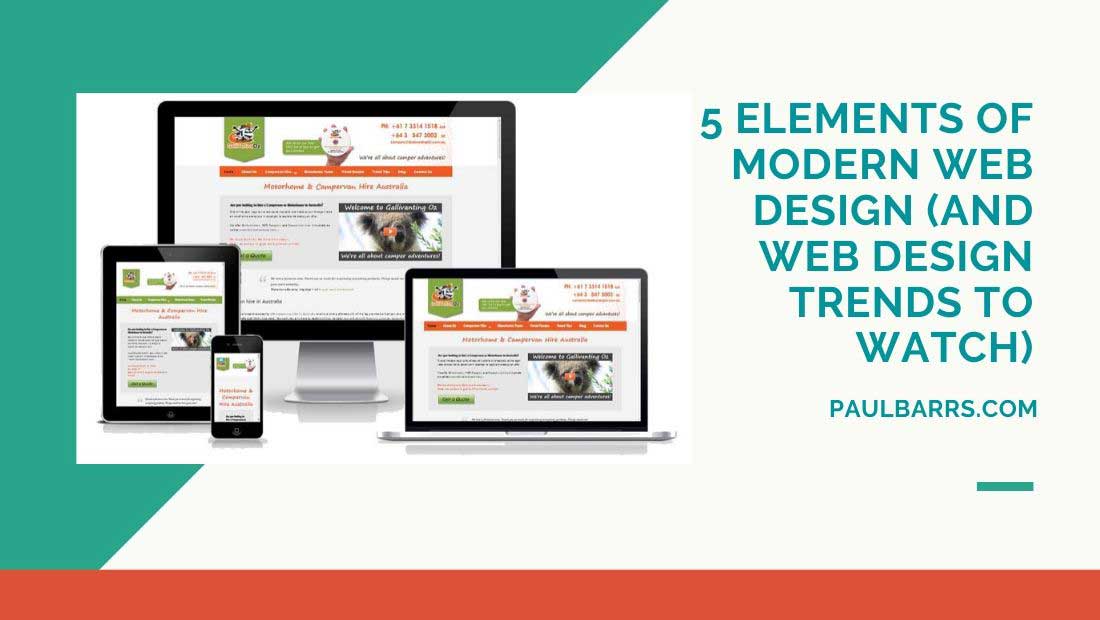
29 Oct 5 Elements of Modern Website Design (And Web Design Trends to Watch)
Are you seeking ways to ensure that your site is a success online? If so, you need to understand how to guarantee your site is on-trend and providing the experience that users want. There are a variety of elements that can help you convey a message, tell a story or ensure that your website is optimised for high conversion rates.
Clear And Open
When you are thinking about your site design, you need to consider whether it is user-friendly and specifically readability. It can be tempting to fill the style with a massive amount of text, images, and video. However, if your page is jumbled with content, it will detract from the experience of the user. It could even lead to a higher bounce rate.
Instead, it’s crucial that content is laid out effectively and forms an organic part of the overall web motif without negatively impact it. This does mean that there should be a substantial level of white space. With white space, there will be a buffer between key elements on the page including a sidebar, margins, and copy. A modern web should have room to breathe and provide the right information in bite-sized chunks. This is also a great way to ensure that your page looks professionally designed.
CTAs
The main purpose of any modern site is always going to be driving sales and converting users into leads. To do this, you need to make sure you are leading customers where you want them to go.
CTAs provide the answer here and also ensure that you gain crucial contact details for further engagement. This could include subscription forms or downloadable ebooks. Ideally, each CTA should be offering value to customers. There are a variety of ways to display CTAs with some more intrusive than others. For instance, floating CTAs are a common part of modern web design. These follow users as they can continue to scroll and will always be displayed on the screen. There should be at least one CTA on every page.
Speed Optimisation
Every site should load in approximately two seconds. If your site takes longer than this to load all the information, a user could get bored and click back. This is particularly relevant in an age where the majority of individuals will be accessing your site from their phone, rather than a desktop computer. Due to this, your web style should have elements that are used to optimize speed levels. There are a variety of strategies to consider here including photo and video optimization and compression of key files. By doing this, you can shave off crucial seconds of load times and guarantee that users are not kept waiting.
One misconception is that by decompressing files, your site is going to look cheap or designed to a poor quality level. However, if this strategy is approached correctly, that won’t be the case.
Videos
We mentioned videos briefly when discussing page style. This should be a key element of a modern site. Videos provide a more immersive way to connect with an audience and a way to effectively convey complex information clearly. With a short video, you won’t have to worry about loading times and it could bring your service to life. This is going to provide a benefit to the user experience without asking them to sit and scroll through a massive amount of content.
Based on research by Inc. Magazine over 90% of B2B customers are watching online videos. Particularly when they begin to research a product or service that they could be interested in investing in. With an option like this, they will quickly understand your selling point and be able to determine if it’s the right choice for their needs.
Large Hero Images
Finally, you should consider implementing a large hero image into your website design. Using this tactic, the site begins with a bold, visually attractive images with a small level of text that matches your brand identity. There are no CTAs or social buttons so you will be providing a strong and clear visual experience.
This can help you tell a story to your audience members and ensure that your message is not lost. It also encourages users to scroll down. It is vitally important that the image you use is responsive. It should show up regardless of what device the individual is using and provide the same, high-quality experience to the user. With professional web design, you can make sure that this is the case and avoid missing out a massive percentage of your audience.


